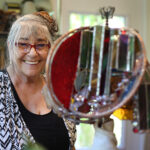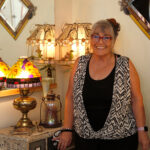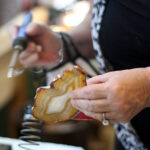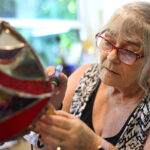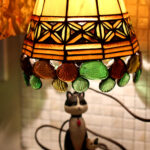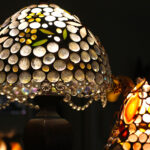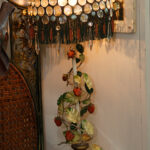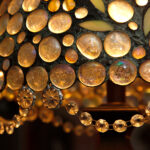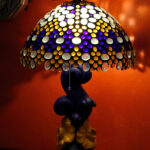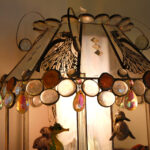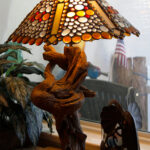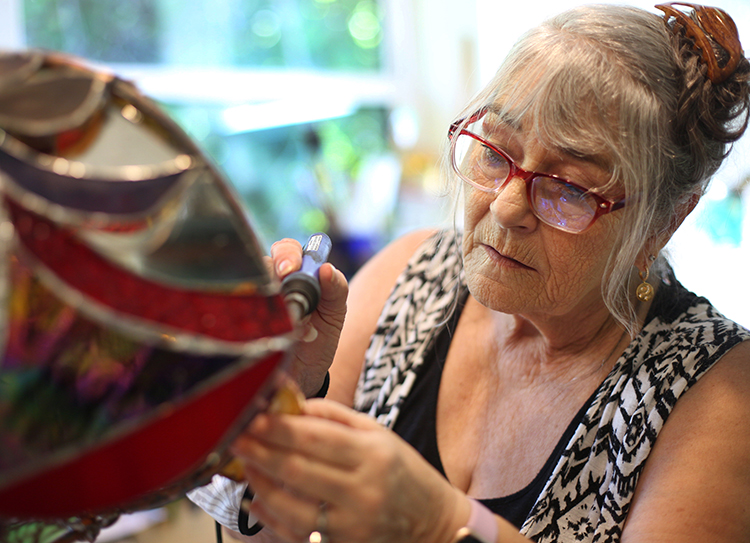
Creativity flourishes within the mind of Holly Wray, a cheerful, multi-talented educator and artist. Wray’s eye-catching, one-of-a-kind lamps made their local debut last June in an exhibition she called ‘A Bucket of Glass’ at San Telmo’s Décor, a lovely antique shop in Sebastian’s Village Square. In addition to gorgeous furnishings and décor, co-owners Manuel Lopez and Jorge Buffa showcase works of art created locally and elsewhere.
“I consider it glass sculpting rather than stained glass. It’s definitely functional art; that’s how I approach it, anyway. It’s not task lighting; it’s just fun. It’s for someone who wants something that nobody else has. And there will never be another one, because I’m just not good enough to do two of any of them,” Wray says with a laugh.
Wray grew up in Stillwater, a tiny mill town of some 1,500 people in upstate New York. After attending the State University of New York at Plattsburgh, she obtained a master’s degree in education at SUNY Albany and went to work as a sixth-grade teacher in her “dream school,” Shenendehowa in Clifton Park, N.Y.
Spelling the town name was “the first thing you had to learn before you got interviewed,” she says with a laugh, adding that it was one of the largest school districts in the state.
“At the time I got hired there were 10,000 kids on campus. Seven elementary schools. It’s a whole school system on campus. It was bigger than any university I ever went to.”
Wray says her first introduction to glass working came when the grandfather of one of her students presented her with a bucket filled with glass. A demolition expert, he had accumulated the glass while taking down an old cathedral.
“He says, ‘My granddaughter said you’d know what to do with this.’ It was a bucket filled with glass and he left it,” recalls Wray with a chuckle. “That’s why I called my show at San Telmo’s Décor ‘A Bucket of Glass.’”
Wray would cut the glass and make little kits before teaching her students how to copper the edges.
“It’s the Tiffany method that I use, with the coppering of the edges, rather than using bulky lead,” she explains. “They were so cautious, because they knew if there was any blood the project was over – and perhaps my job. I did a lot of the work, but they were so proud.”
She left after 14 years when they adopted their daughter, Allyson, from Korea. Allyson now works as a nurse in Sebastian and lives a few houses down from Wray.
Wray and Bill, her husband of more than 40 years, moved from New York to Sebastian so that he could be treated for cancer at Moffett. He lost his courageous battle two years ago.
“I don’t think he would have made the nine years if it hadn’t been for Moffett. They were just wonderful. That’s why this has been such a wonderful adventure for me; to have a new door open.”
Wray says she did a lot of whittling and woodworking while Allyson was a baby, as it was safer than glass. She later set up a spot in the basement for her glass work.
“It’s really dangerous. At any given time I’ve got glass in my feet, I’ve got solder burns on my legs. Bill bought me breaches and they’re great, but you got to put them on. It’s like a Pilates tape; you’ve got to do it and not just watch it.”
Once Allyson started school, Wray went back to school to receive a degree in administration and also studied education law, “because at that time everything was going a little crazy. Everyone had an opinion about absolutely everything.” Noting that things have gotten even worse, she adds, “I don’t know how they do it now.”
She honed her craft by experimenting, reading books on glass and taking classes, including with an artist who deftly cut glass despite only having one arm. “It was absolutely amazing; his balance, his skill. I learned a lot, just watching him. He inspired me.”
Commenting “I’ve always loved different things,” Wray says she finds bases for her lamps anywhere and everywhere, from flea markets to museum shops, whatever catches her eye. She now has shelves filled with pieces just waiting their turn.
Referencing a metal samovar topped with one of her intricate glass shades, she recounts how she got it from an antique shop owner who she helped with auctions. As nobody had shown any interest in the samovar, he said he was going to put it in the dumpster.
“And I said, ‘Oh, may I be your dumpster? I love it. When he asked what I was going to do with it, I said, ‘I’m going to turn it into a lamp.’ That was probably 25 years ago.”
An epergne she bought at a flea market some 30 years ago was finally turned into a lamp about five years ago. “I was just waiting. I knew I loved it.”
Some projects will never be sold, such as a standing lamp that features an elaborate animal carousel she describes as an epic project, taken up after her husband died.
“That was my therapy, my joy, my angel on my shoulder. I said, ‘Look honey, I’m defying gravity again!’” she recalls. “I saw it in my head and kept my fingers crossed that everything would fit the way I hoped it would, and it did. He was an engineer, so it used to drive him crazy that I was defying gravity.”
With many of the shades, she utilizes what she calls ‘globs’ but what are known in the industry as ‘dumps.’ The ovoid pieces are made, she explains, “when there isn’t enough glass for pouring more sheets, they drop the glass into water. They’re all different sizes and colors; they’re so much fun.”
A whole shade made of dumps can also be very heavy when put together with copper and “about three and a half pounds of solder.”
She has also begun experimenting with reverse painting, carefully painting a design on the inside of a glass shade.
“Sometimes I like to go outside my comfort zone. The bases give me an idea, but I’m kind of flexible with things. I used to draw what I saw in my head and then try to work from it. That was way too hard; too limiting. So now I just have the overall feeling and then go ahead and do what I can do to get to where I want to go.”
Wray works out of her home studio, where, she says, “I have totally ruined the rug with solder.”
Currently on her worktable is an almost-finished creation that she is almost ready to light up. Her husband used to do the wiring before teaching her how to do it herself.
Each of the lamp’s multiple sides has, she explains, “a different attitude. It’s two lamps. It has an outer lamp, but when it’s lit, you’re going to see a whole other little world of action going on inside, which I’ve never done before.”
She says San Telmo’s has about a dozen of her imaginative lamps. “I think I brought over another five or six of them after the other ones sold. It’s just been so exciting. The guys are great; they’re so supportive.”
Wray says she found the shop by chance, having wandered in with a friend after lunch.
“Right away, I could see some of my lamps on some of that furniture,” she recalls. After showing them some pictures, they asked if they could come to her home to see them in person.
“They said they were going to take six lamps and they took 14 lamps. They couldn’t narrow it down,” she says with a laugh. “I’m just so appreciative. They’ve been just so great to me. It’s kind of like an extension of family at this point. And that happened fast.”
Photos by Kaila Jones

